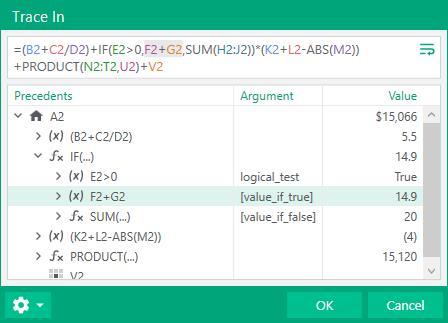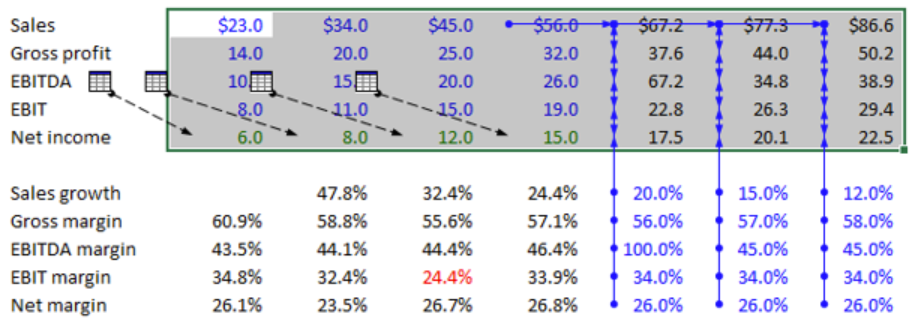Precedents & Dependents
You have probably used Excel's native Trace Precedents/Dependents tools and discovered the limitations of their utility. Macabacus' Trace In / Out—the most advanced auditing tools of their kind—make tracing precedents/dependents very simple and are absolutely essential for any power user.
Trace In

Trace In allows you to effortlessly navigate an audited formula's inputs.
When you activate Trace In, a dialog opens displaying the addresses and values of all cells used in the calculation of the audited cell. Selecting a precedent cell range in the dialog using the up/down arrow keys or the mouse navigates to the precedent range, whether it is outside of the visible range on the same worksheet, on another worksheet, or even in another workbook.
- Drill down — Use intuitive, tree-based navigation. Press the right arrow to expand a node and trace precedents one level deeper. Press the left arrow to move back up a level. Open the Trace In dialog, navigate multiple levels, and close it—all without using your mouse.
- Edit formulas — Use the
F2shortcut to modify the audited formula in Point, Enter, or Edit mode (as indicated in the bottom left corner of the Excel window). Macabacus takes you directly to Point mode when possible, allowing immediate navigation and modification of the precedent range with keyboard arrows. PressF2again to enter Edit mode for other changes. - Move & resize — Trace In has several keyboard shortcuts for repositioning and resizing the dialog. Key
Ctrl+Up,Ctrl+Down,Ctrl+Right, andCtrl+Leftto move the dialog. KeyCtrl+HomeandCtrl+Endto position the dialog at the top left and bottom right corners of the screen, respectively. KeyShift+Up,Shift+Down,Shift+Right, andShift+Leftto resize the dialog.
We also offer Trace Out, which is similar to Trace In, but it traces cell dependencies in the opposite direction.
Click the gear icon to view other settings and options available with Trace In.
- Evaluate Functions and Groups — Enable Trace In to evaluate Excel functions and expressions (e.g., SUM) individually, allowing piece-by-piece analysis. See the contribution of each formula part to the overall result. Toggle this feature with
Ctrl+E. This option will also allow you to trace to the result of a formula, for example, the result of INDEX=. - Highlight Navigated Cells —Shades intersecting rows and columns of the selected range for better navigation. Note: This clears Excel's Undo stack (an Excel limitation). Use this option when reviewing models and data, not when actively building models.
Troubleshooting Trace In / Out
Trace In / Out does not trace a formula properly
- Does the audited formula contain unqualified structured table references (e.g., =SUM([Sales]))? Macabacus can only process fully qualified structured table references (e.g., =SUM(DeptSales[Sales]) in formulas at this time. Fully qualified structured table references must also reference tables within the same workbook.
- Does a precedent or dependent range contain merged cells? Merged cells should be avoided, in general, and Macabacus may be unable to process them. Use
Center Across Selectionas an alternative, if possible. - Macabacus may struggle to parse formulas if your workbook contains many unused range names. Use the Name Scrubber's Clean Names button for a Deep Clean, or manually remove names from the list. If confident hidden names are unused, delete them carefully, as some add-ins, including Macabacus, use hidden names for legitimate purposes.
- If you are still experiencing difficulty, email support@macabacus.com with the information requested here. You should also include a copy/paste of the audited formula or, if at all possible, attached the affected workbook.
Trace Out does not find dependents in certain formulas
If Trace Out doesn't find expected cells, use Excel's Trace Dependents tool. If the cells still don't appear, the formula may contain a volatile function like OFFSET(). Excel can't track dependencies in some volatile functions, and since Macabacus relies on Excel for this data, Trace Out can't find these dependencies either.
Macabacus remembers the last position of Trace In / Out dialogs, which may appear off-screen if you switch to a smaller monitor. UseCtrl+Home or Ctrl+End after launching Trace In / Out to bring the dialog back into view.
The Trace In dialog does not display the full audited formula
If the formula you are auditing contains line breaks (achieved by keyingAlt+Enter ), you must enable theWrap Formula Text setting in the Trace In dialog to view the entire formula.
The up / down arrow keys do not navigate precedents / dependents
If using up/down arrows in Trace In / Out dialogs moves the worksheet cursor instead, another add-in may be causing this. This conflict is known with Workshare and Anaplan add-ins, but others may produce the same result. Disable the conflicting COM add-in to fix the problem.
Show All Arrows
Show All Precedents

Excel natively traces precedents only for the active cell in a selection of multiple cells. In other words, Excel only shows you trace arrows for one cell at a time. Macabacus, on the other hand, shows precedent trace arrows for all selected cells at once. If you repeat this keystroke before changing the cell selection, Macabacus clears the trace arrows.
AutoTrace
AutoTrace will not show trace arrows for selections containing more than 20 cells. Without this limit, navigation might become very slow or Excel could freeze as Macabacus computes precedents / dependents for larger selections.
This documentation refers to the latest Macabacus version. Some features and descriptions of these features may not apply to older versions of Macabacus. Update your Macabacus software to take advantage of the latest features.